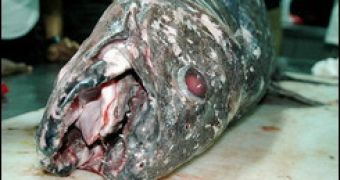This fish is "older" than a living dinosaur. Its species appeared 360 million years ago and its ancestors gave birth to the land vertebrates, in a lineage that culminated with the human evolution. These extremely primitive fishes were thought extinct with the dinosaurs, till the surprise that came in 1938: a living coelacanth fished off eastern Africa.
Since then, other populations of Latimeria (the scientific name of the living coelacanth) were found in other places of the Indian Ocean: off Comoros, Mozambique, Madagascar, Kenya, Tanzania, Sodwana Bay (South Africa).
The even bigger surprise came when a second species of Latimeria was found in Indonesia in 1997, first on a fish market, after that in the ocean.
A precious catch of Latimeria was made two months ago by the Indonesian fisherman Justinus Lahama. French researchers equipped with sonar and GPS asked Lahama to remake, in his dugout canoe, the exact conditions in which he made the catch, close to Manado city (northern Sulawesi island).
Last May 19, Lahama and his son maneuvered their frail canoe within 200 m (660 ft) off the beach. "I very quickly unrolled the usual trawl line with three hooks, about 110 m (yards) long, and at the end of three minutes, I felt a large catch," said Lahama, counting the fierce resistance of the fish. "I had painful arms -- I felt such a resistance, I thought that I was pulling up a piece of coral."
After 30 minutes of struggle under the scorching tropical sun, he spotted the fish at a depth of about 20 m (65 ft). "The sea was very calm this day. There was no wind, no clouds, no current. The water was very clear. The fish let itself be drawn in from there. It was an enormous fish. It had phosphorescent green eyes and legs. If I had pulled it up during the night, I would have been afraid and I would have thrown it back in," he said.
African coelacanths usually live at depths of 200-1,000 meters (656-3,200 feet) and can reach 2 m (6.5 feet) in length and 110 kg (250 pounds) in weight.
Lahama, 48, has fished since for about 40 years, but this was his first ever coelacanth catch: 1.3 m (4.3 ft) long and weighing 50 kilograms (110 pounds). The only other capture of a live Asian coelacanth was made in 1998, also off Manado.
When he showed the fish to an older fisherman, the man got alarmed. "It is a fish which has legs -- it should be given back to the water. It will bring us misfortune," he told Lamaha.
After 30 minutes out of the water, the fish was still alive, and was put in a netted pool facing a restaurant near the beach. The coelacanth survived for another 17 hours.
It was filmed swimming in the 1 m (3.3 ft) deep pool, invaluable images as the species has been previously observed just in caves at great depths. The dead Latimeria was frozen and a French-Japanese-Indonesian team will make its genetic analysis. The shallow site where the fish had been captured has intrigued the researchers: just a depth of 105 meters (350 ft). Does the Asian coelacanth live in shallower waters than its African relative does?

 14 DAY TRIAL //
14 DAY TRIAL //